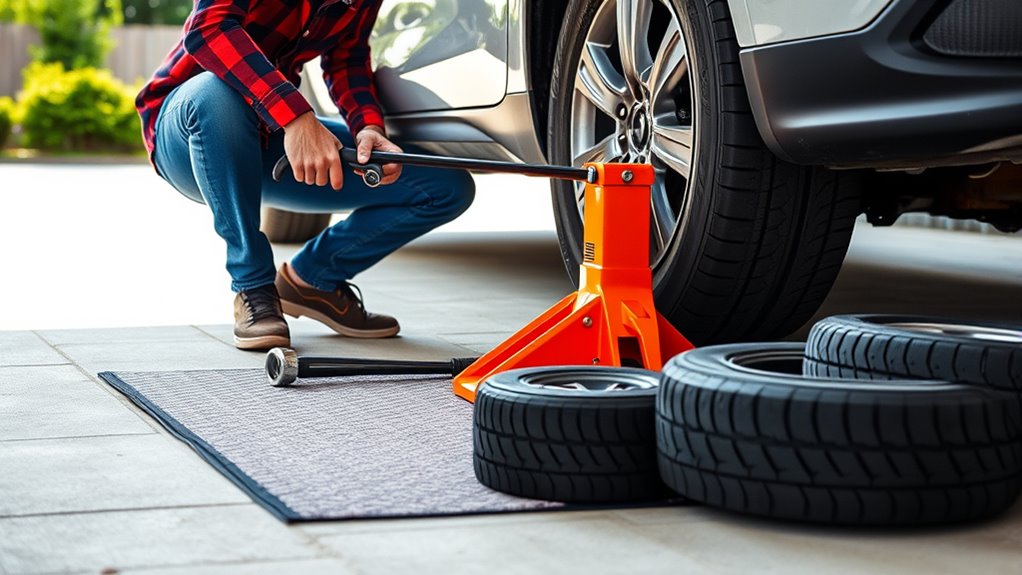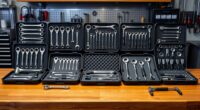To rotate your tires at home, start by parking on a flat surface and securing the vehicle with the parking brake. Loosen the lug nuts slightly, then lift the car with a jack and secure it with jack stands. Remove the wheels and follow your vehicle’s recommended rotation pattern, whether front-to-back or crossing sides. After reattaching the wheels, tighten the lug nuts properly and lower the car. Keep reading to learn how to do it step by step for a smooth process.
Key Takeaways
- Lift the vehicle securely using a jack and jack stands at recommended jacking points.
- Remove the wheels and follow the manufacturer’s specified rotation pattern for your tire type.
- Inspect tires for damage or uneven wear during removal, and note their current positions.
- Reinstall wheels, tightening lug nuts in a star pattern to ensure even pressure.
- Lower the vehicle, recheck torque, and verify proper tire pressure for optimal safety and performance.

Rotating your tires at home is a simple and cost-effective way to extend their lifespan and improve your vehicle’s performance. Proper rotation helps ensure even tire wear, which can lead to better handling, fuel efficiency, and safety. Before you start, it’s important to understand some tire pressure tips. Maintaining the correct tire pressure is essential for peak performance and safety. Check your vehicle’s owner’s manual or the sticker inside the driver’s door for the recommended PSI. Use a reliable tire pressure gauge to regularly check and adjust your tires when they’re cold, as hot tires can give false readings. Properly inflated tires reduce uneven wear and improve traction, making your rotation process more effective.
Once your tires are properly inflated, it’s time to address wheel alignment basics. Good wheel alignment ensures that your tires wear evenly and that your vehicle handles correctly. If your car pulls to one side or if you notice uneven tread wear, it might be time for an alignment check before or after rotating your tires. Correct alignment not only prolongs your tires’ life but also enhances safety and driving comfort. If you’re unsure about your wheel alignment, a quick visit to a mechanic can save you from uneven tire wear down the line. Additionally, understanding city dynamics can help you choose the best routes for regular maintenance visits.
To start the tire rotation process, lift your vehicle using a jack and secure it with jack stands. Always consult your vehicle’s manual for the proper jacking points. Remove the wheels, and then follow the rotation pattern recommended for your tire type and vehicle configuration. Most vehicles follow a front-to-back pattern, but some require cross-rotation, especially for directional tires. Be precise in matching each tire to its new position to avoid confusion later. While removing the wheels, take the opportunity to inspect the tread and sidewalls for signs of damage or uneven wear, which could indicate alignment issues or other problems.
After reattaching the wheels, tighten the lug nuts in a star pattern to evenly distribute pressure. Lower the vehicle carefully and double-check the torque specifications with a torque wrench. Once the tires are mounted and torqued, recheck the tire pressure and make adjustments as needed. Remember, regular tire rotations combined with tire pressure tips and awareness of wheel alignment basics help you get the most out of your tires, ensuring safer and smoother rides for miles to come.
Frequently Asked Questions
Can I Rotate Tires Without a Jack or Tools?
You can’t safely rotate tires without a jack or proper tools. DIY safety is essential; attempting to do so without the right equipment can cause accidents. While tool alternatives like a sturdy floor jack or car ramps might work, they still require caution. Always prioritize safety, use proper tools, and consider professional help if you lack the necessary equipment. Never compromise safety for convenience when working under your vehicle.
How Often Should I Check Tire Pressure After Rotation?
You should check your tire pressure at least once a month after rotation to ensure proper tire maintenance and safety precautions. Regular checks help you catch leaks or pressure drops early, maintaining ideal handling and fuel efficiency. Always verify your vehicle’s recommended PSI, and use a reliable gauge. Consistent pressure checks prevent uneven wear, extend tire life, and keep you safe on the road.
Is It Necessary to Balance Tires After Rotation?
You should balance your tires after rotation to keep everything running smoothly—it’s better to be safe than sorry. Tire wear can develop unevenly if you skip this step, especially if your rotation pattern has changed or if you notice any vibrations. Balancing helps prevent uneven wear and extends tire life. Don’t overlook it; balancing is a small step that can save you money and hassle down the road.
Can I Rotate Tires on an AWD Vehicle Myself?
Yes, you can rotate tires on an AWD vehicle yourself, but you need to be cautious. Check tire wear patterns and verify your wheel alignment is correct before rotating. Typically, front-to-back rotation works, but some vehicles require cross-pattern rotation. Remember to tighten lug nuts properly and inspect for uneven wear or damage. Regularly monitoring tire wear and maintaining wheel alignment will help your AWD vehicle perform safely and efficiently.
What Should I Do if a Tire Is Damaged During Rotation?
If you damage a tire during rotation, stop immediately and assess the damage. You might consider tire patching if the puncture is small, but avoid patching if the damage is severe or near the sidewall. Remember, repairing a damaged tire could affect your warranty considerations, so check your manufacturer’s guidelines. For safety, it’s best to replace the tire if repairs aren’t suitable, ensuring your vehicle stays roadworthy.
Conclusion
Now that you know how to rotate your tires at home, you’re all set to save money and extend their lifespan. But here’s the catch: if you skip this step or do it improperly, you might face unexpected issues on the road. Will your tires last longer than you think? Or will neglect lead to costly repairs? Keep an eye on your tires, stay vigilant, and remember—sometimes, the smallest maintenance can make the biggest difference.









